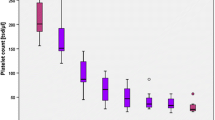Abstract
Heparin-induced Extracorporeal LDL <total cholesterol, triglycerides, fibrinogen >Precipitation (H.E.L.P.) was applied in cases of acute thromboembolic stroke within 48 to 96 hours after onset. 42 patients had been randomized for the trial. In Group A 12 patients underwent a single H.E.L.P. application, while remaining 10 patients formed a control group. In group B 10 patients had 10 H.E.L.P. applications, the other 10 patients firmed as controls. Results of group A: 4 days after H.E.L.P. an improvement in the Mathew Scale and in the Mini Mental State Examination could be obtained (p<0.05 each). 10 days after H.E.L.P. all the tests showed significant changes (p<0.05 in the Mathew Scale and in the Mini Mental State Examination and p<0.01 in the Activities-of-Daily-Living Score). Relatet to the controls there appeared a statistically significant difference 4 days after H.E.L.P. in the Mini Mental State Examination and in the Activities-of-Daily-Living Score (p<0.05 each). At day 10 all the tests showed a difference to the controls (p<0.05 in the Mathew Scale and p<0.01 in the other tests). Results of group B 10: One day after 1st H.E.L.P. a statistically significant difference could be observed in all the tests (p<0.05 in the Mathew Scale and the Mini Mental State Examination and p<0.01 in the Activities-of-Daily-Living Score). At that time even a difference to the controls became visible (p<0.05 in the Mathew scale, p<0.01 in the other tests). Up to 5 H.E.L.P. applications and in relation to the initial values a further improvement could be seen in the Mathew Scale (p<0.05) as well as in the Mini Mental State Examination and in the Activities-of-Daily-Living Score (p<0.01 each). However, no further improvement was observed between the 5th and the 10th H.E.L.P., but the difference to the controls remained stable in the Mathew Scale and Mini Mental State Examination (p<0.05 each) and in the Activities-of-Daily-Living Score (p<0.01).
Sommario
Prime esperienze nell'applicazione della precipitazione LDL extracorporea indotta da eparina (H.E.L.P.) nella fase acuta nell'ictus tromboembolico.
La precipitazione extracorporea LDL (colesterolo totale, trigliceridi, fibrinogeno) indotta da eparina (H.E.L.P.) è stata utilizzata nella fase acuta dell'ictus tromboembolico, tra 48 e 96 ore dall'esordio. Quarantadue pazienti sono stati scelti per randomizzazione.
Nel gruppo A, 12 pazienti sono stati sottoposti ad un'unica applicazione di H.E.L.P., mentre i restann dieci hanno costituito il gruppo di controllo. Nel gruppo B, 10 pazienti sono stati sottoposti a 10 applicazioni di H.E.L.P., mentre altri 10 hanno accettato di costituire il gruppo di controllo.
Risultati del gruppo A: quattro giorni dopo l'applicazione H.E.L.P. si è verificato un miglioramento nella scala di Mathew e nel Mini Mental State (p<0.005 in entrambi).
Dieci giorni dopo l'H.E.L.P. tutti i tests hanno dimostrato un miglioramento significativo (p<0.05 nella scala di Mathew e nel Mini Mental State; p<0.01 nel Activities-of-Daily-Living Score. Rispetto al gruppo di controllo si è dimostrata una differenza statisticamente significativa quattro giorni dopo l'H.E.L.P. al Mini Mental State e all'Activities-of-Daily-Living Score (p<0.05 in entrambi). Al giorno dieci, tutti i tests hanno dimostrato una differenza rispetto ai controlli (p<0.05 alla scala di Mathew e p<0.01 negli altri tests).
Risultati del gruppo B: un giorno dopo l'applicazione della prima H.E.L.P. è stata osservata una differenza statisticamente significativa in tutti i tests (p<0.05 alla scala di Mathew e al Mini Mental State; p<0.01 all'Activities-of-Daily-Living Score).
Contemporaneamente, si è resa evidente una differenza statisticamente significativa rispetto ai controlli (p<0.05 alla scala di Mathew, p<0.01 agli altri tests).
Fino alla 5 applicazione H.E.L.P., rispetto ai valori di base è stato dimostrato un miglioramento alla scala di Mathew (p<0.05), al Mini Mental State (p<0.01) e all'Activities-of-Daily-Living (p<0.01).
Tuttavia, non si sono osservati ulteriori miglioramenti tra la 5a e la 10a applicazione H.E.L.P.; la differenza rispetto ai controlli si è mantenuta invariata alla scala di Mathew e al Mini Mental State (p<0.05) e all'Activities-of-Daily-Living (p<0.01).
Similar content being viewed by others
References
Bleecker M., Bolla-Wilson K., Kawas C., Agnew J.:Age Specific Norms for the Mini-Mental State Examination. Neurology 38:1565–1568, 1988.
Dignan M.B., Howard G., Toole J.F. et al:Evaluation of the North Carolina Stroke Care Program. Stroke, Vol. 17, 3:382–386, 1986.
Ernst E.:Hämorheologie-Theorie, Klinik, Therapie. Schattauer-Verlag, Stuttgart-New York, 1989.
Grotta J., Ackerman R., Correia J. et al.:Whole Blood Viscosity Parameters and Cerebral Blood Flow. Stroke, Vol. 14, 3:296–301, 1982.
Hsu C.Y., Norris J.W., Hogan E.L. et al.:Pentoxifylline in Acute Nonhemorrhagic Stroke. Stroke, Vol. 19, 6:716–722, 1988.
Lechner H., Ott E., Fazekas F.:Cerebrovascular Disease. Where are we now? In: Gotoh F., Lechner H. eds. Clinical Hemorheology: A new Approach to Cerebrovascular Disease. Royal Society of Medicine Services. International Congress and Symposium Series 100, Oxford University Press, Oxford, England, 11–18, 1986.
Lechner H., Niederkorn K., Suzuki H.:Hemorheologic Parameters in Correlation to Extracranial carotid Artery Disease in Patients with Acute Cerebrovascular Disorders. Eur. Neurol. 27:139–141, 1987.
Lechner H., Walzl M., Walzl B. et al.:The Influence of the H.E.L.P. System in Cerebrovascular Disease, Weighted on Hemorheological Factors, Medical Biophysics, 2:147–150, 1991.
Ott E., Lechner H.:High Blood Viscosity in Cerebral Infarction. Stroke 5:330–333, 1974.
Seidel D.:The H.E.L.P. System, an efficient and safe method of plasmatherapy in the treatment of severe hypercholesterolemia. Therapeutische Umschau, 47:514–519, 1990.
Tanahashi N., Gotoh F., Tomita M. et al.:Enhanced Erythrocyte Aggregability in Occlusive Cerebrovascular Disease. Stroke, Vol. 20, 9:1202–1207, 1989.
Wilhelmsen L., Svardsudd K., Korsan-Bengtsen K. et al.:Fibrinogen as a Risk Factor for Stroke and Myocardial Infarction. N. Engl. J. Med., Vol. 311, 8:501–505, 1984.
Author information
Authors and Affiliations
Rights and permissions
About this article
Cite this article
Lechner, H., Walzl, M., Walzl, B. et al. First experience in application of heparin-induced extracorporeal LDL precipitation (H.E.L.P.) in acute thromboembolic stroke. Ital J Neuro Sci 14, 251–255 (1993). https://doi.org/10.1007/BF02335667
Received:
Accepted:
Issue Date:
DOI: https://doi.org/10.1007/BF02335667




